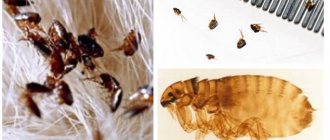A cat is a favorite of the whole family, it brings comfort to our home, gives its owners warmth and joy. For his part, a person must take care of the animal and monitor its health. The main problem that cat owners face is the diseases of their pets, as well as various parasites that often bother them. Fleas are the most common parasite on cats, especially when it comes to animals that walk outside. These require immediate and decisive action on the part of the owner because they seriously undermine their health. These parasites can be carriers of dangerous diseases and pose a danger to humans. They do not live on it, but can feed on its blood through bites.
You can remove fleas from a cat at home, but you should first show the animal to a veterinarian. These pests lead to serious weakening of the animal, in advanced cases it causes anemia, weakens the immune system, which can cause other, more serious diseases. That is why any cat owner should know the first signs of these insects, as well as how to get rid of them.
Cat flea: who is it and where does it come from?
To understand where cats get fleas from, you should learn more about these parasites: their structure, feeding habits, and life cycle. Fleas are a huge order of wingless insects that are blood-sucking exoparasites and parasitize on any animal. They have a rather narrow specialization: there are fleas of rabbits (Spilopsyllus cuniculi), dogs (Ctenocephalus canis), humans (Pulex irritans) and cats (Ctenocephalides felis). These insects also parasitize rats and birds. Outwardly, they are very similar; only a professional entomologist can determine the exact type of insect.
general description
What does a flea look like on a cat? Their body size ranges from 1 to 5 mm, the cat flea reaches approximately 2 mm. Males are smaller than females. The parasite that has sucked blood increases sharply in size—approximately 2 times. The insect's body is flattened laterally (this makes it easy to move between hairs) and covered with numerous spines and bristles. They help the insect to stay between the hairs of fur or feathers.
The oral apparatus of the parasite is of the piercing-sucking type, which includes a special stylet that pierces the skin of the host. They do not have a proboscis. The limbs of the parasite are strong, they give it the ability to move along surfaces at any angle, as well as make long jumps. The abdomen has special tactile hairs that are sensitive to air vibrations.
They are wingless insects - with their lifestyle, wings would only get in the way of the parasite. The shape of the body and the chitinous cover make mechanical damage to the insect very difficult - it cannot be crushed with your fingers. The parasite can only be destroyed by crushing it with a fingernail on a hard surface.
This is interesting! Fleas are one of the best jumpers in the animal kingdom. Having a size of only a few millimeters, they can jump 19 cm in height and 30 cm in length. This is a hundred times the size of their own body. A person, in order to repeat these results, must long jump 160 meters.
Life cycle
Fleas are insects with a full life cycle; they have the stages of adult insect, egg, larvae and pupae. The female lays her eggs anywhere, and after about two weeks a worm-like larva appears, which grows and molts several times. The larvae live in dust and debris, feeding on decaying organic matter and excrement.
Later, the larva pupates and after a while emerges from the pupa as an adult insect. Now she just needs to find her owner.
The insect's lifespan is approximately 2 years. Parasites reproduce very actively; during her life, the female lays up to 2 thousand eggs.
Cat fleas can also spread to rats, and they displace the rat flea.
Eating habits
Each type of parasite prefers its own host. They adapt to a certain skin structure, its temperature, the composition of the host’s blood and other characteristics. They can feed on the blood of other animals, but they do not do this very willingly.
Although, it should be noted that in this regard the cat flea is the most picky, as it can easily drink both dog and human blood. She is the champion in the number of bites to people.
Typically, these insects do not live permanently on their host. Rather, it serves as their dining room. They attack him from time to time, drink his blood and leave again. They live near their owner. There are some types of fleas that live permanently on their host; these are parasites of nomadic animals.
They feed daily, but can easily endure several months of fasting, after which they pounce on food with particular greed.
This is interesting! Fleas have changed little over the past 50 million years. The fossil insects that scientists studied are almost no different from modern ones. Evolution, apparently, considered that it had already created a masterpiece, which did not make sense to change.
Diseases
Fleas are carriers of serious diseases in humans and domestic animals. Rat pests are especially dangerous. They carry plague, typhus and other serious diseases. In the Middle Ages, entire cities died out from plague epidemics transmitted by rats.
Fortunately, the cat flea does not carry such dangerous diseases, but other types of these insects can live on your pet.
Where do fleas come from on a domestic cat?
The most careful care of your pet, even if it does not go outside, is not a 100% guarantee that your pet will not have parasites. People often ask how a domestic cat got fleas if it has never left the premises or interacted with outdoor animals. In fact, the transfer of parasites from one animal to another is just one way of infection. There are several of them:
- walking on land infested with flea eggs;
- contact with an infected animal;
- brought into the house by a person (most often these are insect eggs, but there may also be adults).
Therefore, a pet can easily pick up these ubiquitous parasites. If your pet walks outside, then the probability of infection is almost 100%.
Up to 200 insects can live on one animal at the same time.
Treatment of fleas in cats
How to remove parasites from a pet is the first question that faces the owner when fleas are discovered. Skin parasites in cats are quite difficult to treat. This is due to the fact that it is necessary not only to treat the pet itself, but also to carry out preventive measures for other animals in the house. Comprehensive measures are also needed to eliminate parasites in the area surrounding the cat. If all preventive measures are not taken, treatment will not be effective, since flea eggs and larvae can be found anywhere. The animal will become infected again.
To treat cat fleas, follow these steps:
- First, you need to wash your pet with a drug that has parasite-killing properties. This can be a special shampoo, soap, drops, powders or aerosols. Some drugs have contraindications, so before using the product, you need to carefully read the instructions.
- To prevent fleas in the future, you can periodically use products taken orally: drops, mixtures or soluble tablets. An anti-flea collar also has an excellent effect.
- It is worth regularly brushing your pet's fur using special combs. Fleas are easily combed out of the fur and can be killed. If the animal has long hair, you should not regret it and cut it off completely. This will help get rid of parasites much faster.
- It is also important to treat the cat bites themselves. This will relieve it from itching, and the restoration of the skin and hair will be much easier and faster.
Do not use multiple flea treatments at the same time. Each of them is effective individually, but together they can negatively affect the pet’s body.
To eliminate parasites from the room where the animal lives, you must:
- Vacuum it completely using a vacuum cleaner with a water filter. Eggs and larvae fall into the water, with which they are then flushed down the toilet. If you have an ordinary vacuum cleaner, after cleaning you must immediately clean the glass from the accumulated dust, and it is better to throw away the bag and replace it with a new one. Particular attention should be paid to the cat's sleeping or most favorite place. This is where the largest concentration of flea eggs is.
- The places where the animal lives most should be sprayed with anti-flea spray, especially hard-to-reach places: baseboards, cabinets, table legs. Having an ultraviolet lamp will also help get rid of some types of fleas.
- Bedding, sofa covers, bedspreads on which a pet could lie should be washed in water at a sufficiently high temperature, or even better, boiled. The cat's carrier should also be thoroughly cleaned.
Cat on the litter
- While your four-legged friend is sick, you need to minimize the space where he can move. This will make it easier to carry out preventive maintenance on the premises. It is best to give the cat a separate room or buy a cat house-cage where the animal can live for several weeks until it is completely free of fleas.
- At dachas or country houses, the surrounding area also needs to be cleared of flea eggs and larvae. Otherwise, after some time the pet will attach them to the fur again, and the disease will return. Parasites live in damp, shady places with organic food. Therefore, it is these areas that need to be treated first and especially carefully.
How to tell if a cat has fleas
How to determine if a cat has fleas? This is one of the most frequently asked questions on this topic. It is quite simple to identify parasites on an animal’s body; there are characteristic signs of this disease that are hard to miss:
- The pet not only itches, but violently bites into the fur, which it does especially often.
- The animal is restless and very nervous. Insects cause severe itching, depriving them of their usual rest. Often meows pitifully, trying to attract your attention.
- When scratching, you can see brown lumps - these are parasite excrement.
- Also, when combing, the parasites themselves are visible.
The disease is conventionally divided into several stages. Immediately after infection (the first stage), the animal’s behavior is not much different from usual - the cat eats normally and is playful. Visually detecting parasites is almost impossible because there are very few of them.
The only symptom that may indicate that pest infestation has occurred is your pet's frequent scratching.
At the second stage of infection, the animal’s behavior changes greatly: it begins to get nervous, sleeps poorly, constantly itches and tries to gnaw out pests with its teeth. Scratches and wounds appear on the body. At this stage, parasites can be easily detected visually.
If measures are not taken immediately, the disease will progress. Your affectionate, sociable and cheerful cat will turn into a gloomy and downtrodden animal. In addition, infection in an advanced stage has unpleasant health consequences:
- the animal loses weight and becomes weaker;
- stops playing;
- the fur falls out in clumps;
- Frequent vomiting may begin;
- various dermatitis develops.
It can be added that in caring owners, the infection does not reach the third stage. It is difficult not to notice parasites already at the second stage of the disease, and the means that exist now (this will be discussed in detail below) allow you to effectively and fairly quickly get rid of these insects.
The most favorite places for fleas to live on a cat’s body are the stomach, neck area and the jaw area. It should be remembered that they are not the only parasites that can appear on your pet. There are also lice eaters, but they are usually located on the fur, and fleas prefer the skin of the animal.
How to detect fleas on cats
Two cats are itching from fleas
How to find out if a cat has fleas is a question that worries every owner. It is very easy to determine this; you just need to observe the pet and its behavior. At first, scabies in cats is almost invisible. It is possible to detect flea bites, but only if the owner carefully cares for the animal's fur. Dry dark crusts will be visible in the abdomen and back area. This is blood digested by a flea. But then the infected cat will constantly itch. The more parasites appear, the more pronounced the itching becomes. Sometimes cats scratch the bitten areas until they bleed.
Why are cat fleas dangerous?
Infection with them is dangerous not only because of the deterioration of your pet’s general condition; there are also other reasons why you should rid your animal of these parasites as quickly as possible. These are diseases that are transmitted by fleas and can be dangerous for both the cat and its owners.
Danger for cats
In addition to a noticeable deterioration in physical and mental condition, fleas very often cause allergic dermatitis. Also, these insects are carriers of helminths. To date, it has been proven that these parasites are intermediate hosts of several dozen species of worms. The larvae feed on worm eggs, and they are also stored inside the adult insect. A cat may well become infected with helminths by biting into insects.
Fleas are carriers of infectious anemia - hemobartonellosis, which leads to a decrease in red blood cells in the animal's blood. They also carry dangerous fungal and viral diseases. Among them are mycoplasmosis - it affects various organs, as well as rickettsiosis - a disease characterized by a febrile state of the animal.
Severe infestation with them can lead to complete or partial baldness of the pet - the lost hair will never grow back. In addition, your pet may develop serious mental problems.
Danger for kittens, pregnant and lactating cats
Fleas pose an even greater danger to kittens. A fragile body is not able to fight parasites, so they often cause their death. Flea infestation in kittens leads to the following consequences:
- rapid weight loss and cessation of growth;
- the occurrence of anemia.
It is this disease that most often causes the death of an animal.
Parasites are also dangerous for pregnant cats. They deprive them of nutrients and weaken the animal. There is one more point - many of the anti-flea drugs are toxic. Their entry into the body of a pregnant woman can negatively affect the offspring. The situation is similar with feeding animals. Veterinarians advise to carry out the destruction of parasites before future mating, so you can avoid the harmful effects of parasites and medications.
Danger to humans
Cat fleas also bite humans, although they do so reluctantly and quite rarely. As mentioned above, these insects have a rather narrow specialization and prefer to feed on the blood of one host. Bites are fraught with both minor troubles and serious consequences, in the form of dangerous diseases carried by parasites.
When bitten, the parasite injects an anesthetic and an anticoagulant into the victim's body, which prevents blood clotting. Both of these proteins are foreign to us, and the human immune system instantly reacts to this - an allergic reaction begins (itching, burning, inflammation). Multiple bites disfigure the skin, it becomes covered with wounds and scratches. The legs suffer the most; the insect can jump up to about a person’s knee.
There is another danger - diseases that fleas carry:
- pulicosis;
- massive dermatitis;
- dipylidosis;
- brucellosis;
- creeping erythema;
- anthrax.
How to get rid of fleas on a cat
Those faced with this scourge ask questions:
How to kill fleas on a cat and what to use to get them out?
What methods and drugs are the most effective and least harmful to the health of the animal?
It is also important to know how to completely expel fleas from your home. As mentioned above, parasites do not live permanently on an animal, they use it only for food, and they usually live and reproduce somewhere nearby.
Treatment of fleas in cats
Today, there are a large number of methods and means that allow you to cure a cat very quickly and effectively. Here are the main ones:
Drops - applied to the animal’s withers, are very effective and allow you to quickly solve the problem. They have a residual effect. Their main disadvantage is the likelihood of developing allergies.
Sprays are a fairly effective remedy that can cure in a short period of time. They act effectively, have no residual effect, but rarely cause allergies.
Shampoos are the most gentle and effective remedy for fleas in cats, however, they are not so easy to use (bathing some cats is very difficult). When using shampoo, be careful not to get the product into the animal's eyes.
A collar is more about preventing fleas in cats than treating them. It is better to use it after applying the methods described above. It is especially relevant for pets that go outside. In addition to protecting against parasites, it shows workers of special services that the animal is not homeless, but has an owner.
There are also tablets and powders against these insects, but they are less convenient to use. It is quite possible to remove fleas from a cat at home, but before treating your pet it is better to consult a veterinarian.
Removing parasites indoors
It is not enough to get rid of parasites on the animal itself; they should also be destroyed in the premises.
First of all, you need to take care of the place where the animal lives - the bedding needs to be changed or boiled. Then, you should treat all surfaces in the apartment on which adult parasites, their eggs and larvae may remain.
The premises are cleaned using special products that can be purchased at a veterinary pharmacy.
What do fleas look like on cats?
The most common types of fleas are cat fleas. It is this species that is most often found on pets, dogs, and rabbits. They can also feed on human blood. But the variety of parasites living on cats is diverse: dog, rat, rabbit and more than two thousand species.
Pet owners often wonder what a flea on a cat looks like? How can you understand that it is she and not some insect?
cat flea
The flea has a small head, rounded in front, and a strong body flattened on the sides with bristles and spines. This allows fleas to move through the pet’s fur with lightning speed, making them extremely difficult to catch.
Parasites feed at the expense of their host. With strong jaws they bite through the skin of the animal and suck the blood out of it. Parasites can go without food for a long time. Therefore, these animals live for quite a long time.
Life cycle of cat fleas
Fleas reproduce quite quickly. The female lays approximately seven eggs at a time. This comes out to about three hundred pieces per day. But the eggs are not sticky and do not linger on the cat’s body. They fall to the place where pets most often sleep, scratch or lick themselves. When the animal moves, it can get into the carpet pile and cracks in the floor.
The next stage of flea development is the appearance of the larva. You can understand what flea larvae look like by imagining a white worm.
This is what a cat flea larva looks like
They don't have paws. But on the body, like an adult, there are hairs. They can reach five millimeters in length. In appearance there is a similarity to fly larvae, but flea maggots are much more mobile.











